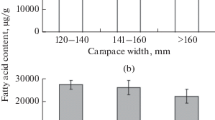Abstract
Freshly caught orange roughy (Hoplostethus atlanticus) obtained at the edge of the Chatham Rise, east of the South Island of New Zealand, in June 1988, were used to investigate tissue-specific lipid synthesis and to obtain blood for plasma lipoprotein analysis. Tissue slices prepared from an intraneurocranial fat deposit, pieces of skull (neurocranium), swimbladder and liver were incubated with radioactive acetate, palmitate and oleate, and the labelled lipids extracted and analysed. All four tissues could incorporate acetate label into fatty acids which were themselves incorporated into triacylglycerols and phospholipids although not into wax esters, the most abundant lipid class in these tissues. Exogenous palmitate and oleate were also incorporated into more complex lipids, with the label from oleate (but not palmitate) being found in wax esters as well as triacylglycerols and phospholipids. The distribution of the label in the wax esters showed that some reduction of the fatty acid to fatty alcohol had occurred. The only exception to this pattern was the swimbladder, which incorporated small amounts of palmitate-label into both the fatty acid and fatty alcohol portions of the wax esters. Lipoproteins were isolated from serum by centrifugation. All lipoprotein classes contained phospholipid, cholesterol, triacylglycerol, cholesteryl esters and wax esters. A very low-density lipoprotein class also contained large amounts of unesterified fatty acids, which are possibly artefacts resulting from storage of the samples. Significant quantities ofω-3 fatty acids were also found in the serum lipids.
Similar content being viewed by others
Literature cited
Bligh, E. G., Dyer, W. J. (1959). A rapid method for total lipid extraction and purification. Can. J. Biochem. Physiol. 37: 911–917
Body, D. R. (1985). The composition of orange roughy (Hoplostethus atlanticus) roe lipids. J. Sci. Fd Agric. 36: 679–684
Buisson, D. H., Body, D. R., Dougherty, G. J., Eyres, L., Vlieg, F. (1982). Oil from deep water fish species as a substitute for sperm whale and jojoba oils. J. Am. Oil Chem. Soc. 59: 390–395
Cynamon, H. A., Isenberg, J. N., Nguyen, C. H. (1984). A rapid method for erythrocyte membrane phospholipid determination. Clinica chim. Acta 144: 65–70
D'Auost, B. G. (1967). “Anaerobic” glycolysis under hyperbaric oxygen in the gas gland of the vermillion rockfish,Sebastodes miniatus. Ph. D. thesis. University of California, San Diego
Grigor, M. R., Thomas, C. R., Jones, P. D., Buisson, D. H. (1983). Occurrence of wax esters in the tissues of the orange roughy (Hoplostethus atlanticus). Lipids 18: 585–588
Heath, R. A. (1981). Physical oceanography of the waters over the Chatham rise. New Zealand Oceanographic Institute, Wellington (NZOI Oceanography Summary No. 18)
Lowry, O. H., Rosebrough, N. J., Farr, A. L., Randall, R. J. (1951). Protein measurement with the Folin phenol reagent. J. biol. Chem. 193: 265–275
Nevenzel, J. C. (1970). Occurrence and biosynthesis of wax esters in marine organisms. Lipids 5: 308–319
Phleger, C. F. (1988). Importance of skull lipid as an energy reserve during starvation in the ocean surgeonfish,Acanthurus bahianus. Comp. Biochem. Physiol. 91A: 97–100
Phleger, C. F., Patton, J., Grimes, P., Lee, R. F. (1976). Fish-bone oil: percent total body lipid and carbon-14 uptake following feeding of 1-14C-palmitic acid. Mar. Biol. 35: 85–89
Rosecchi, E., Tracey, D. M., Webber, W. R. (1988). Diet of orange roughy,Hoplostethus atlanticus (Pisces: Trachichthyidae) on the Challenger Plateau, New Zealand. Mar. Biol. 99: 293–306
Sargent, J. R., Gatten, R. R., Merrett, N. R. (1983). Lipids ofHoplostethus atlanticus andH. mediterraneus (Beryciformes: Trachichthyidae) from deep water to the west of Britain. Mar. Biol. 74: 281–286
Sargent, J. R., Lee, R. F., Nevenzel, J. C. (1976). Marine waxes. In: Kolattukudy, P. E. (ed.) Chemistry and biochemistry of natural waxes. Elsevier, Amsterdam, p. 49–91
Stewart, J. C. M. (1980). Colorimetric determination of phospholipids with ammonium ferrothiocyanate. Analyt. Biochem. 104: 10–14
Author information
Authors and Affiliations
Additional information
Communicated by G. F. Humphrey, Sydney
Rights and permissions
About this article
Cite this article
Grigor, M.R., Sutherland, W.H. & Phleger, C.F. Wax-ester metabolism in the orange roughyHoplostethus atlanticus (Beryciformes: Trachichthyidae). Mar. Biol. 105, 223–227 (1990). https://doi.org/10.1007/BF01344290
Accepted:
Issue Date:
DOI: https://doi.org/10.1007/BF01344290



